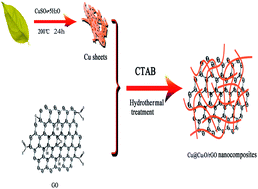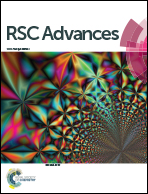Reticular-vein-like Cu@Cu2O/reduced graphene oxide nanocomposites for a non-enzymatic glucose sensor†
Abstract
In this work, reticular-vein-like Cu@Cu2O/rGO nanocomposites have been synthesized by direct redox reaction of Cu and graphene oxide (GO) through a hydrothermal method where the macropore Cu sheets served as the precursor of reticular-vein-like Cu2O as well as the reducing agent of GO. FESEM and TEM were employed to characterize the morphology of the as-prepared samples. The results reveal that the reticular-vein-like Cu@Cu2O nanocomposites are homogeneously anchored onto rGO and act like the skeleton supporting the rGO sheets to avoid its aggregation or stacking. Electrochemical tests show that the Cu@Cu2O/rGO modified glassy carbon electrode (GCE) exhibits remarkable electrocatalytic activity towards glucose oxidation in both alkaline medium and human serum, including a wide linear range (0.005–7 mM), a low detection limit (0.5 μM), a rapid response (<2 s) as well as good stability and repeatability. More importantly, the interference from the commonly interfering species such as lactose, fructose, ascorbic acid (AA) and uric acid (UA) can be effectively avoided. All these results indicate this novel nanostructured material is a promising candidate for non-enzymatic glucose sensors.


 Please wait while we load your content...
Please wait while we load your content...